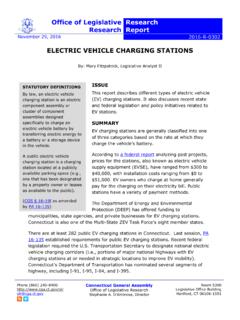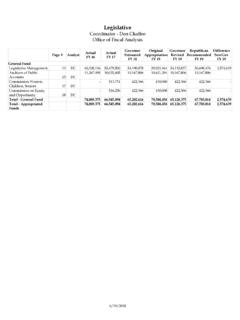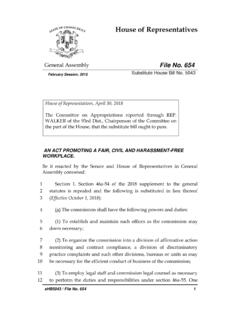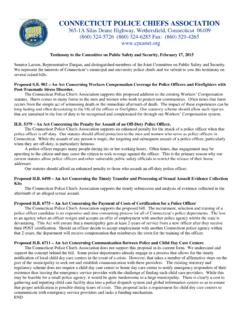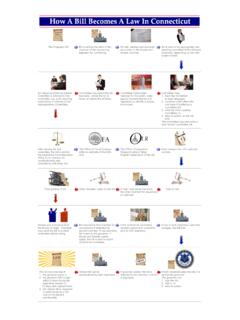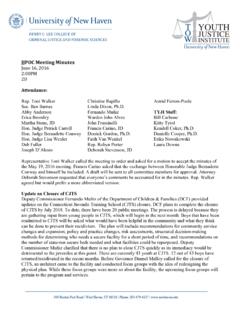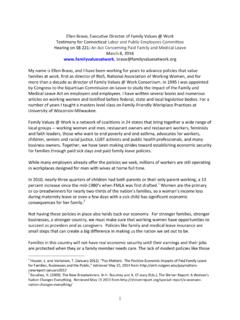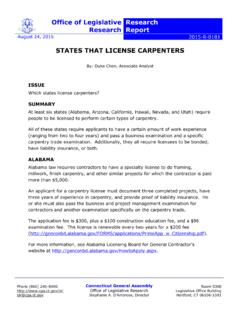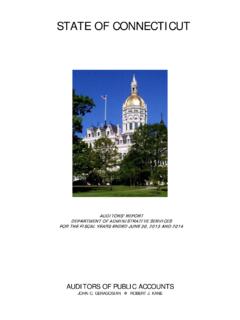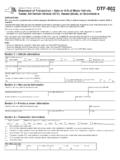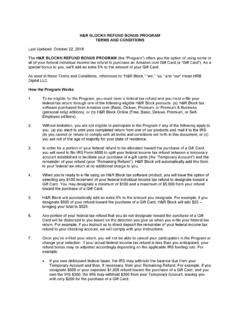Transcription of Estate, Inheritance, and Gift Taxes in CT and Other States
1 Connecticut General Assembly Office of Legislative Research Stephanie A. D Ambrose, Director (860) 240-8400 Room 5300 Legislative Office Building Estate, Inheritance, and gift Taxes in CT and Other States By: Rute Pinho, Chief Analyst September 2, 2020 | 2020-R-0180 Issue What is the difference between estate, inheritance, and gift (EIG) Taxes ? What is Connecticut s gift and estate tax and how does it compare to those in Other States ? This report updates OLR Report 2016-R-0224. Summary EIG Taxes are Taxes levied on the transfer of property ( , cash, securities, real estate, business interests, and Other assets).
2 Estate and inheritance Taxes are imposed on transfers that occur upon the owner s death, while gift Taxes are imposed on transfers that occur during the owner s lifetime. A total of 12 States and the District of Columbia impose estate Taxes , while six States impose inheritance Taxes (Maryland imposes both). Connecticut is the only state that imposes a stand-alone gift tax. For 2020, Connecticut s estate tax applies to estates valued at more than $ million. This taxable threshold is scheduled to increase to $ million for 2021, $ million for 2022, and the federal basic exclusion amount ( , federal threshold) for 2023 and thereafter (CGS 12-391(g)).
3 (The federal threshold is $ million for 2020.) The same thresholds apply to Connecticut s gift tax, which is unified with the estate tax. This means that gifts a decedent made during his or her lifetime are treated as part of the estate and taxed at the same rates. 2020-R-0180 September 2, 2020 Page 2 of 6 Until 2023, Connecticut s estate and gift tax rates are marginal rates based on the value of the taxable estate or gift . For 2020, there are six rate brackets ranging from for estates and gifts valued between $5,100,001 and $6,100,000 to 12% for those valued at $10,100,001 and greater.
4 Beginning in 2023, the tax rate is set at a flat 12% of the value of the taxable estate or gift over the federal threshold. The maximum amount of tax that a donor or decedent will be required to pay is $15 million for deaths occurring or gifts made after January 1, 2019 (CGS 12-391(g)). Among the District of Columbia and 12 States that impose estate Taxes , Connecticut s $ million tax threshold ranks 9th for 2020 and its 12% top rate ties with Maine as the lowest. What are EIG Taxes ? EIG Taxes are imposed on transfers of property, either upon the property owner s death or during his or her lifetime.
5 Table 1 lists the States that impose these Taxes . Estate Taxes apply to the taxable value of a decedent s estate at his or her death, after deductions and exemptions. These deductions include property that passes to surviving spouses and qualifying charities. The estate itself is liable for the tax. Inheritance Taxes (also known as succession Taxes ) apply to the taxable value of property left to heirs. The tax rates and thresholds vary based on the class of heir to whom the property is transferred. Lineal heirs ( , children, grandchildren, and parents) are typically taxed at lower rates than distant relatives or unrelated heirs.
6 The heirs themselves are liable for the tax, but the estate pays it. gift Taxes apply to property transferred during a property owner s lifetime, thus preventing individuals from avoiding paying estate and inheritance Taxes by transferring their assets while alive. The donor is generally responsible for paying the tax. Table 1: State EIG Taxes States with Estate Taxes 12 States and Connecticut District of Columbia Hawaii Illinois Maine Maryland Massachusetts Minnesota New York Oregon Rhode Island Vermont Washington States with Inheritance Taxes 6 States Iowa Kentucky Maryland Nebraska New Jersey Pennsylvania States with gift Taxes 1 State Connecticut Source: Minnesota House of Representatives Research Department.
7 Survey of State Estate, Inheritance, and gift Taxes . July 2018 2020-R-0180 September 2, 2020 Page 3 of 6 Connecticut s gift and Estate Tax Estate Tax Basis Connecticut s estate tax applies to both resident and nonresident estates valued at more than the taxable threshold; for 2020, that threshold is $ million. The tax applies only to the value of the estate above the threshold. A resident estate is an estate of a decedent who was domiciled in Connecticut at the time of death. A nonresident estate is an estate of a decedent who was not domiciled in Connecticut at the time of death but owned real or tangible personal property here.
8 The starting point for calculating the Connecticut estate tax is the decedent s gross estate for federal estate tax purposes, minus federally allowable deductions ( Other than the state death tax deduction). The decedent s gross estate for federal estate tax purposes generally includes the fair market value at the time of his or her death of all property, wherever it is located. This includes real property ( , real estate), tangible personal property ( , automobiles, boats, and jewelry), and intangible personal property ( , bank accounts, cash, stocks, and pensions).
9 The federally allowable deductions include the marital deduction, for property that passes to the surviving spouse, and the charitable deduction, for property the decedent leaves to a qualifying charity. For Connecticut estate tax purposes, the taxpayer must then add to the estate the (1) total value of all Connecticut taxable gifts the decedent made during his or her lifetime, on or after January 1, 2005, Other than gifts already included in the decedent s federal gross estate, and (2) amount of any Connecticut gift tax the decedent or his or her estate paid during the three years preceding the decedent's death for gifts the decedent or his or her spouse made (CGS 12-391.)
10 Department of Revenue Services (DRS), CT Estate and gift Tax Return Instructions). Property of a decedent s estate that is treated, for federal estate tax purposes, as qualified terminable interest property (QTIP) is automatically treated as QTIP for Connecticut estate tax purposes. (QTIP trusts are an estate tax planning tool for married couples used to defer estate Taxes until the last spouse dies. They allow property in a decedent s estate to qualify for the marital deduction even though it is subject to certain restrictions.
